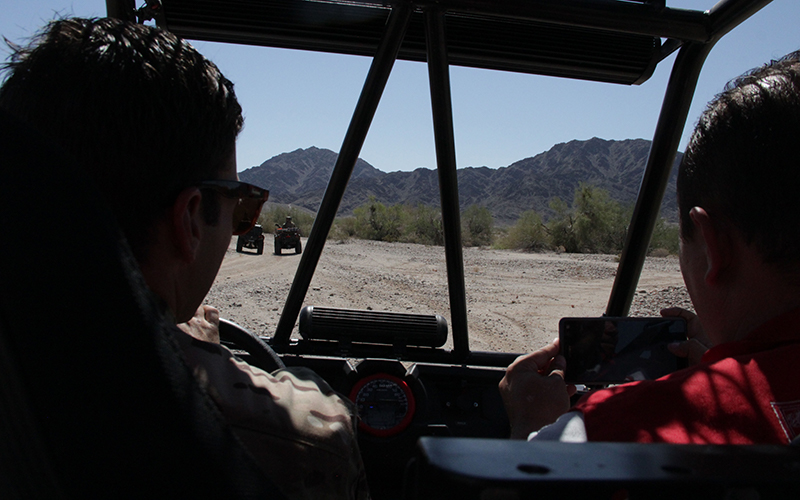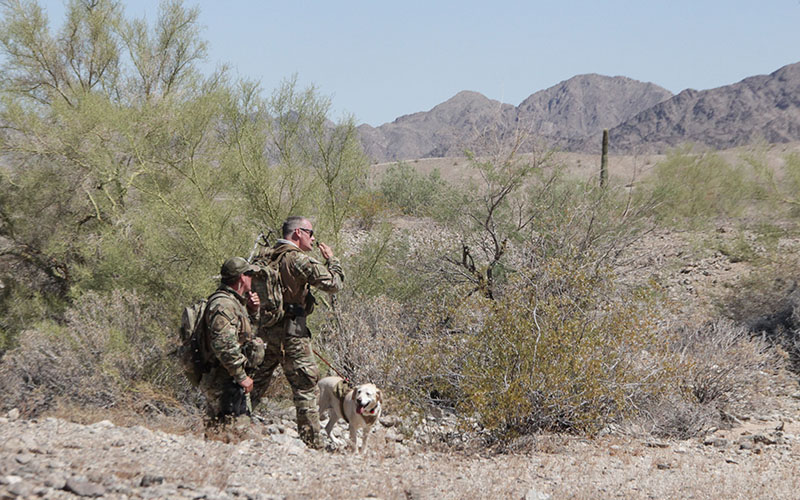
U.S. Border Patrol agents Kevin Michael, left, and Fidel Cabrera talk to reporters about search and rescue efforts to save people who fall ill or are injured while trying to cross the border into the U.S. (Photo by Devin Conley/Cronkite News)

When the El Centro Border Patrol Sector receives a call of an injured or distressed traveler they will search the desert. People who try to cross the border into the U.S. anticipate the journey will only take a day when it can take up to five days in the desert’s extreme heat, a spokesman said. (Photo by Devin Conley/Cronkite News)

U.S. Border Patrol agents drive ATVs with extensions to carry distressed travelers on stretchers to safety. The vehicles can climb high up mountains and handle tough terrain better than trucks. (Photo by Devin Conley/Cronkite News)

Agents work in pairs in ATVs so they can travel for long distances or relieve agents who have been searching for hours. The U.S. Border Patrol headquarters in Yuma is about 20 miles from the Mexico border. (Photo by Devin Conley/Cronkite News)

Agents will use dogs to track scent when clothing or empty water jugs are found. Searchers also use the angle of the sun to track footprints and movement. (Photo by Devin Conley/Cronkite News)

U.S. Customs and Border Protection sends helicopters to search higher ground when looking for someone in distress. Helicopters can save hours of searching on foot. (Photo by Devin Conley/Cronkite News)

Border patrol agents, in a media demonstration, “rescue” an agent posing as border crosser who was injured and left behind. Agents point out the carpet on the shoes, a common method to cover tracks to avoid discovery.(Photo by Devin Conley/Cronkite News)

People who are ill or injured often are airlifted to safety. Those with minor problems such as dehydration are taken to a Yuma medical facility while those with more serious illnesses or injuries are taken to a Phoenix hospital. (Photo by Devin Conley/Cronkite News)
YUMA – The U.S. Border Patrol and Mexico emergency dispatchers are collaborating to save the lives of people who are crossing the U.S. border in the desert heat and succumbing to illness or injury.
The program led to the rescue of a young boy and, later, a married couple who ran out of water after walking for two days, Carlos Beltran, a Mexico dispatcher, said in Spanish.
“When one country collaborates with another country, both countries benefit,” Beltran said.
Border Patrol search and rescue agents this week demonstrated what they do for the media, saying agents’ job is not only to deport people who cross into the country illegally. Justin Kallinger, a Border Patrol spokesman, said they have another imperative: to help people survive.
“It’s all about the human side of it. No one wants to see someone hurt or injured,” Kallinger said.
A long, deadly journey
Mexico residents risk a dangerous journey through desert terrain to cross into the United States illegally. What some expect to be a one-day hike often stretches to five, agents said. Border crossers often don’t take enough water and become dehydrated in scorching summer temperatures.
At some point, they have to decide whether to keep going, and risk death, or make a desperate call for help.
“One of the first things a victim of dehydration will do is strip off their clothes thinking that will cool them down,” said agent Brett Worsencroft. “They will get delirious and that’s usually when they’ll call.”
That cell phone call might not reach the right people in the U.S. Perhaps it was made to a local sheriff’s office and the person did not speak fluent Spanish.
Working to save lives
Under the new system, a 911 call from a cell phone with a Mexican carrier is automatically routed to the Mexico emergency-communications agency, Mexico’s Command, Control, Communications and Computer Agency.
The center employees can better pinpoint the caller’s location through cell towers and speak with them more fluently, Kevin Michael, a Border Patrol supervisor, said. They relay the information to the Border Patrol, which starts rescue operations.
They use ATVs, K9 units and helicopters to find people in distress. Those who have minor injuries or illnesses such as dehydration are taken to a Yuma hospital while those in more serious condition are flown to Phoenix for medical attention.
Once someone’s health is restored, they are taken to a detention center for eventual return to Mexico.
On the Southwest border that stretches from California to Texas, almost 4,000 border crossers were rescued in 2016, according to the Border Patrol. It’s unknown how many people were rescued because of the new collaboration with Mexico, Border Patrol agents said.
“It’s hard to say if we have more rescues,” Michael said of the months-old collaboration with the Mexico emergency-communications agency. “Before this we didn’t know how many calls we might have been missing.”
No matter the numbers, the collaboration with Mexico is valuable, those involved in the program said.
“Without them we can’t complete the puzzle that we have here,” Kallinger said.
(Video by Sunaina Tandon/ Cronkite News)